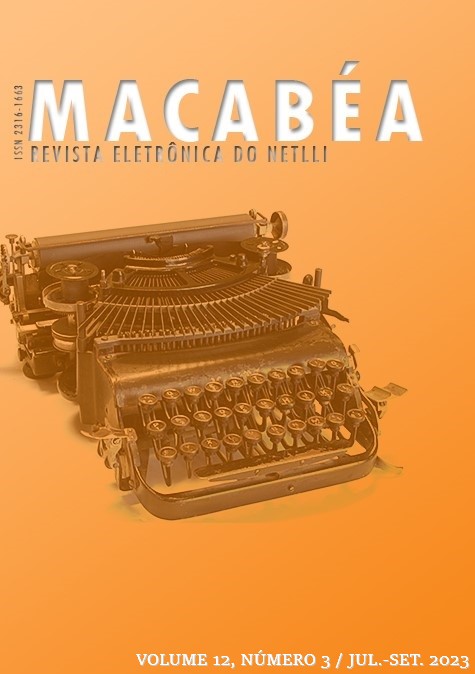RELAÇÕES INTERTEXTUAIS E EFEITOS DE SENTIDOS NO GÊNERO MEME
DOI:
https://doi.org/10.47295/mren.v12i3.1034Abstract
We aimed to analyze the intertextual relations by co-presence in examples of the meme genre. Based on this, we have two specific objectives, namely: (a) to identify different intertextual categories in examples of memes circulated on the Internet and (b) to understand the effects of meaning constructed from the intertextual relations by co-presence in the selected memes. For that, we built a corpus with 6 (six) memes linked on the Internet, in the period 2019-2023. This work is of a qualitative nature with an interpretative approach. Thus, the data obtained were analyzed and interpreted in the light of the relevant literature on the subject in question. Among the studies that comprise the theoretical framework, we highlight Piégay-Gross (1996); Koch, Bentes and Cavalcante (2008); Fávero Koch (2012), Koch (2015, 2017); Lima et al. (2021), among others. The analyzes revealed that, in the corpus of this study, the intertextual relations by co-presence occur through the following categories: reference, allusion and citation. Among the conclusions reached, it should be noted that, in the context of the selected memes, intertextual relations are of paramount importance for the composition and functioning of this textual genre. Furthermore, intertextual relationships promote the construction of different meaning effects such as criticism, political positions, alerts and, above all, humor.
References
ABRAHÃO, V. B. B. Semântica, enunciação e ensino. [recurso eletrônico]. Vitória: EDUFES, 2018.
ANTUNES, I. Textualidade: noções básicas e implicações pedagógicas. São Paulo: Editora Parábola, 2017.
CAVALCANTE, M. M. Os sentidos do texto. São Paulo: Contexto, 2018.
CAVALCANTE, M. M.; OLIVEIRA, R. L. de. O recurso aos memes em diferentes padrões de gêneros à luz da Linguística Textual. Revista Desenredo, Passo Fundo, v. 15, n. 1, p. 8-23, 2019.
DAWKINS, R. O gene Egoísta. São Paulo: Companhia das Letras, 2007.
FÁVERO, E. L.; KOCH, I. V. Linguística Textual: Introdução. 10 ed. São Paulo: Editora Cortez, 2012.
GERHARDT, T. E.; SILVEIRA, D. T. Métodos de pesquisa. Rio Grande do Sul: Editora da UFRGS, 2009.
GUERRA, C.; BOTTA, M. G. O meme como gênero discursivo nativo do meio digital: principais características e análise preliminar. Domínios de Lingu@gem, Uberlândia, vol. 12, n. 3 jul. - set. 2018. p. 1859-1877.
KOCH, I. V. Desvendando os segredos do texto. 8 ed. São Paulo: Editora Vozes, 2015.
KOCH, I. V. Introdução à linguística textual: trajetória e grandes temas. 2. ed. São Paulo: Editora Contexto, 2017.
KOCH, I. V. O texto e a construção dos sentidos. 10. Ed. São Paulo: Editora Contexto, 2016.
KOCH, I. V.; BENTES, A. C.; CAVALCANTE, M. M. Intertextualidade: diálogos possíveis. 2. ed. São Paulo: Cortez editora, 2008.
KRISTEVA, J. Introdução à semanálise. São Paulo: Perspectiva, 1974.
LIMA, A. A. S. et. al. Ambiguidade no gênero meme e a construção de sentido pelo efeito de humor. Miguilim – Revista Eletrônica do Netlli, Crato, v. 10, n. 4, p. 1733- 1752, 2021.
MAINGUENEAU, D. Gênese dos discursos. Curitiba: Cria Edições, 2005.
MARCUSCHI, L. A. Linguística de texto: o que é e como se faz? 3 ed. São Paulo: Editora Parábola, 2020.
MARCUSCHI, Luiz Antônio. Produção textual, análise de gêneros e compreensão. São Paulo: Parábola Editorial, 2008.
MARTINO, L. M. S. Teoria das mídias digitais: linguagens, ambientes e redes. 2. ed. Petrópolis: Vozes, 2015.
PEREIRA, M. L. de S.; VIANA, R. B. de M.; HOLLANDA, Y. R. de. Intertextualidade em memes do Chapolin Sincero. In.: FRANÇA, Marcos de; SOUZA, Adílio Junior de; GRANGEIRO, Cláudia Rejanne Pinheiro; PEREIRA, Maria Lidiane de Sousa. (org.). Estudos linguísticos e literários: abordagens. Araraquara: Letraria, 2020, p. 349-372.
PIÈGAY-GROS, Nathalie. Introduction à l’intertextualité. Paris: Dunod, 1996. Traduzido por Mônica Magalhães Cavalcante; Mônica Maria Feitosa Braga Gentil; Vicência Maria Freitas Jaguaribe. Interseções: Revista de Estudos Interdisciplinares, Rio de Janeiro, n. 1, p. 220-244, 2010.
PIÈGAY-GROSS, N. Introduction à l’intertextualité. Paris: Dunod, 1996.
ROJO, R.; BARBOSA, J. P. Hipermodernidade, multiletramentos e gêneros discursivos. São Paulo: Editora Parábola, 2015.
SILVA, A. V. M. da. Memes, educação e a cultura do compartilhamento nas redes sociais. Revista de Estudos em Linguagens e Tecnologias – ARTEFACTUM, v. 17, n. 2, p. 1-19, 2018.
Downloads
Published
How to Cite
Issue
Section
License
Copyright (c) 2023 Maria Lidiane de Sousa Pereira, Laís Leite de Sousa, Francisca Damiana Formiga Pereira

This work is licensed under a Creative Commons Attribution-NonCommercial-ShareAlike 4.0 International License.
Autores que publicam nesta revista concordam com os seguintes termos:
a. Autores mantém os direitos autorais e concedem à revista o direito de primeira publicação, com o trabalho simultaneamente licenciado sob a Licença Creative Commons Attribution que permite o compartilhamento do trabalho com reconhecimento da autoria e publicação inicial nesta revista.
b. Autores têm autorização para assumir contratos adicionais separadamente, para distribuição não-exclusiva da versão do trabalho publicada nesta revista (ex.: publicar em repositório institucional ou como capítulo de livro), com reconhecimento de autoria e publicação inicial nesta revista.
c. Autores têm permissão e são estimulados a publicar e distribuir seu trabalho online (ex.: em repositórios institucionais ou na sua página pessoal) a qualquer ponto antes ou durante o processo editorial, já que isso pode gerar alterações produtivas, bem como aumentar o impacto e a citação do trabalho publicado (Veja O Efeito do Acesso Livre).










